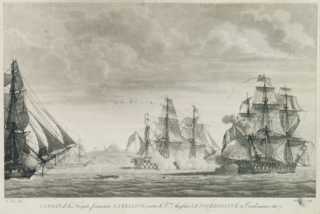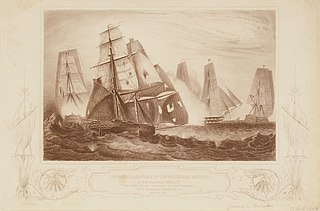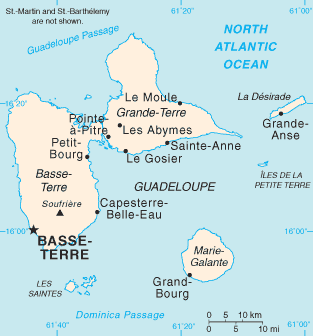
Admiral Sir Samuel Pym KCB (1778–1855) was a British admiral, brother of Sir William Pym.

HMS Centaur was a 74-gun third rate of the Royal Navy, launched on 14 March 1797 at Woolwich. She served as Sir Samuel Hood's flagship in the Leeward Islands and the Channel. During her 22-year career Centaur saw action in the Mediterranean, the Channel, the West Indies, and the Baltic, fighting the French, the Dutch, the Danes, and the Russians. She was broken up in 1819.

Jean-Baptiste Philibert Willaumez was a French naval officer and nobleman who served during the French Revolutionary Wars and Napoleonic Wars. Willaumez joined the French Navy at the age of 14, and proved to be a competent sailor. Having risen to the rank of pilot, he started studying navigation, attracting the attention of his superiors up to Louis XVI himself. Willaumez eventually became an officer and served under Antoine Bruni d'Entrecasteaux in his expedition to rescue Jean-François de Galaup, comte de Lapérouse and explore the Indian Ocean and Oceania.

Bellone was an Iphigénie-class 32-gun frigate of the French Navy on plans by Léon-Michel Guignace. She took part in the American Revolutionary War in the Indian Ocean with the squadron under Suffren, and later in the French Revolutionary Wars. She was present at the Glorious First of June.

The invasion of Martinique was a successful British amphibious operation against the French colony of Martinique that took place between 30 January and 24 February 1809 during the West Indies campaign of 1804–1810 of the Napoleonic Wars. Martinique, like the nearby island of Guadeloupe, was a major threat to Britain's trade in the West Indies, providing a sheltered base from which privateers and French Navy warships could raid British merchant shipping and disrupt the trade routes that maintained the economy of the United Kingdom. Both islands also provided a focus for larger-scale French operations in the region and in the autumn of 1808, following the Spanish alliance with Britain, the Admiralty decided to order a British squadron to neutralise the threat, beginning with Martinique.

Troude's expedition to the Caribbean was a naval operation by a French force under Commodore Amable-Gilles Troude during the Napoleonic Wars. The French squadron departed from Lorient in February 1809 in an attempt to reach and resupply the island colony of Martinique in the Caribbean Sea, then under invasion from a British expeditionary force. The force arrived much too late to affect the outcome of the successful invasion and took shelter from a British squadron in the Îles des Saintes, where they were blockaded by part of the British invasion fleet, led by Vice-Admiral Sir Alexander Cochrane. Two weeks after the French ships arrived, British troops invaded and captured the Saintes, constructing mortar batteries to bombard the French squadron. With his position unsustainable, Commodore Troude decided to break out.

The action of 10 November 1808 was a minor naval engagement of the Napoleonic Wars, in which a British frigate defeated and captured a French frigate in the Bay of Biscay. The action formed part of the blockade of the French Biscay ports during the war by the British Royal Navy, a strategy designed to prevent ships from entering or leaving French harbours, thus eliminating foreign trade with France and damaging the French economy as well as cutting France off from her overseas colonies. The French ship in the action, Thétis, was destined for the French held West Indian island of Martinique with a cargo of flour and military supplies, including over 100 soldiers to reinforce the island's garrison.

The action of 22 January 1809 was a minor naval engagement fought off the Caribbean island of Guadeloupe during the Napoleonic Wars. The action was fought as part of the blockade of Guadeloupe and neighbouring Martinique by a large British Royal Navy squadron, which was seeking to cut the islands off from contact and supplies from France by preventing the passage of shipping from Europe to the islands. The British blockade was part of their preparation for planned invasions during the next year.

The Sirène was a 40-gun Coquille class frigate of the French Navy. She took part in a number of campaigns and actions before she was badly damaged in a battle on 22 March 1808. Refloated after being beached to avoid capture, she was hulked. Sirène was broken up in 1825.
Éléonore-Jean-Nicolas Soleil was a French Navy officer and captain.
HMS Mosambique was the French privateer schooner Mosambique, built in 1798, and commissioned as a privateer in 1804. The British Royal Navy captured her in 1804 and took her into service. She served in the West Indies, engaging in several indecisive single-ship actions before she captured one French privateer. She was sold there in 1810.
Jean-François Lemaresquier was a French naval officer.

Faune was a French naval Abeille-class brig-corvette launched in 1804 to a design by François Pestel in 1803. She participated in the capture of HMS Blanche in July 1805. The Royal Navy captured Faune in August 1805. She was taken into service as HMS Fawn, but the last record of her dates to 1806. In 1807 the Royal Navy launched a new HMS Fawn.

HMS Crescent was a 36-gun Flora-class frigate of the British Royal Navy. Launched in 1784, she spent the first years of her service on blockade duty in the English Channel where she single-handedly captured the French frigate, La Reunion. In 1795, Crescent was part of a squadron commanded by George Elphinstone, that forced the surrender of a Batavian Navy squadron at the capitulation of Saldanha Bay. After serving in the West Indies, Crescent returned to home waters and was wrecked off the coast of Jutland on 6 December 1808.

Cygne was an Abeille-class 16-gun brig of the French Navy, launched in 1806.

HMS Barbuda was commissioned into the Royal Navy in 1780 after having briefly served as an American privateer. Barbuda was one of the two sloops that captured Demerara and Essequibo in 1781, but the French Navy captured her there in 1782 and took her into service as Barboude. The French Navy sold her to private owners in 1786, and she served briefly as a privateer in early 1793 before the French Navy purchased her again and named her Légère. She served them until mid-1796 when the Royal Navy captured her and took her into service as HMS Legere. She was wrecked off the coast of Colombia, without loss of life, in February 1801.
Italienne was a 40-gun Consolante-class frigate of the French Navy, built by engineer Denais after plans designed by Sané and revised by François Pestel. Under Commander Jurien de La Gravière, she took part in the Battle of Les Sables-d'Olonne, where she sustained very severe damage.

Éveillé was an Artésien-class 64-gun ship of the line of the French Navy, launched in 1772.

Jean François Denis de Keredern de Trobriand was a French Navy officer. He notably served during the American Revolutionary War.














